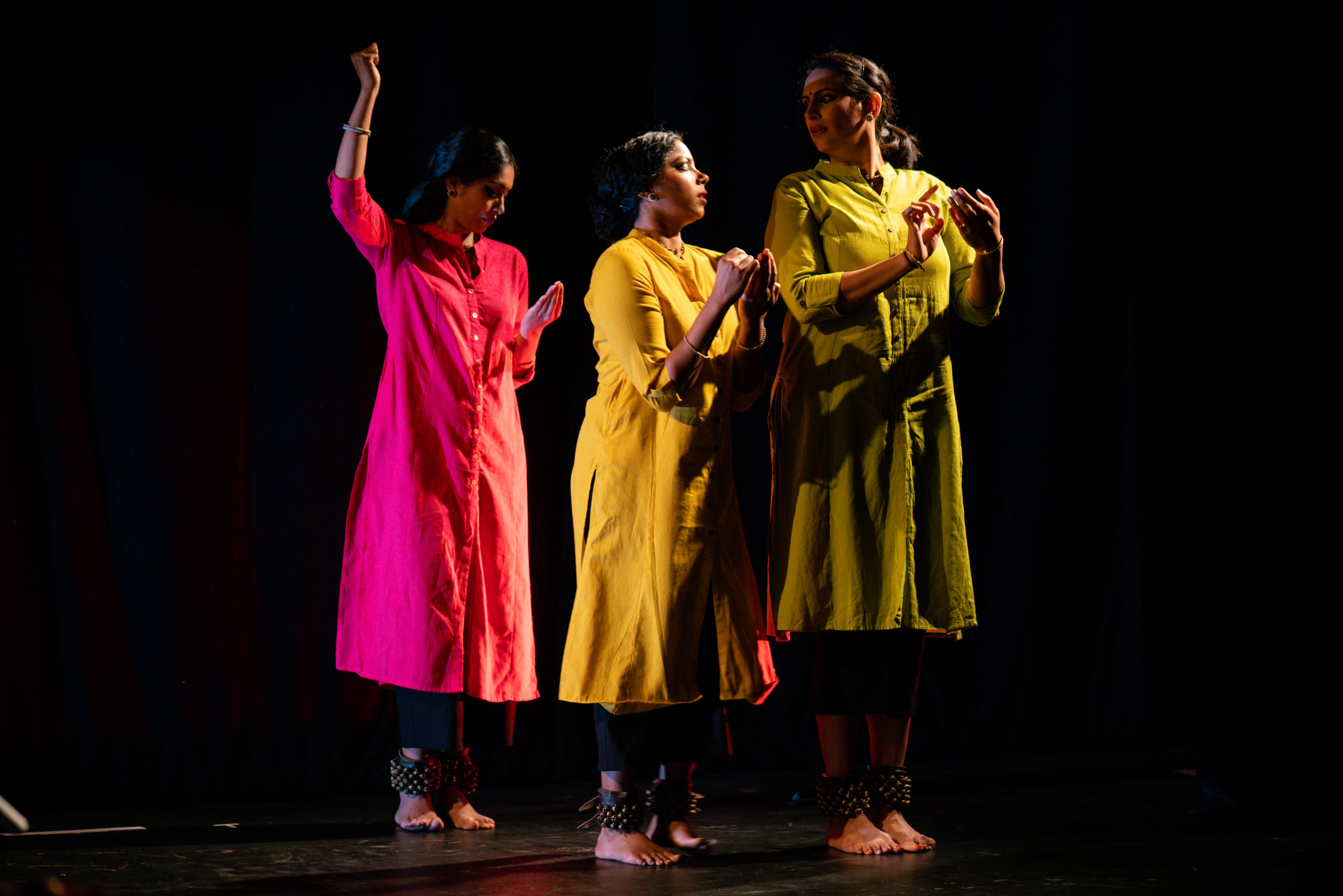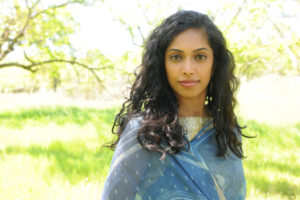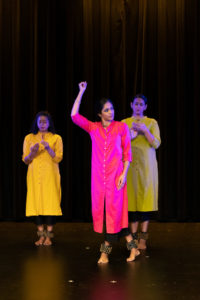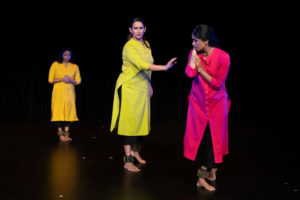
Photo by Leo Resplandor

As a dancemaker, my chosen form of expression is bharatanatyam, a traditional dance form of South India. Like many traditional art forms, bharatanatyam feels precious, like something that has traveled through time and space but at the same it’s very much alive and changing. There is so much of bharatanatyam that digs deep, that connects the artist and the observer on a personal level. But, as a choreographer, how do I negotiate the boundaries of bharatanatyam to create work that 1) embodies the art form I believe in and 2) reflects my experience as a first generation, American-born, Malayalee, woman?
I was born in the US, my first language was English, and I was raised Catholic. Bharatanatyam is an art form from India, danced to Indian languages I couldn’t understand, and draws inspiration from the gods and goddesses of Hindu mythology. Technically, there is very little about bharatanatyam that is supposed to feel familiar to me. But despite my lack of familiarity, bharatanatyam connected me to characters in Hindu mythology and made them relatable. It explored the human emotions that I saw every day and found them in mythological stories and ancient poetry. Through these experiences, I’ve seen that bharatanatyam has the kind of power that makes what seems foreign actually seem familiar, and this is one of the primary reasons I believe bharatanatyam can be used to bridge the cultural differences in our communities.
Bharatanatyam is becoming increasingly prevalent in the diaspora, with teachers all over the Bay Area. But perhaps because of how tradition can be misperceived as rigid or dated, it’s largely losing relevance in today’s youth, where creativity and thinking outside the box is encouraged. At the same time, it feels like who we are as South Asians in the diaspora is changing. In this era, we are being discriminated against because of our skin color, because of our religion, or because of our legal status, and as a community we are responding to those injustices. If our art forms are supposed to reflect who we are, then they need to embody our activism. What if it’s not mythology, but history that moves us? What if it’s not a story at all, but an emotion or reaction to what is going on in the world? Could we use bharatanatyam to explore these perspectives, or do we need to redraw the boundaries?
In Broken Seeds Still Grow (2017), co-creators Rupy C. Tut and I explored communal violence and divisions in secular communities during the 1947 Partition of British India through visual art and dance. In the choreography, I retained the bharatanatyam vocabulary, expressive mime, and set the dance largely to classical Indian music (composed by GS Rajan). I sidestepped some conventions by deconstructing movement, experimenting with improvisation, and adding a western instrument and music (by cellist Chris Evans.)
But I believe the two biggest deviations from bharatanatyam were 1) taking on a political theme based on true eyewitness accounts and 2) partnering with an Indian miniature painter to tell the story. As a result of our partnership, Rupy and I created a layered narrative that reminded people of their own stories of displacement, regardless of background, while we reimagined what was possible with both our traditional forms.

Earlier this year I premiered Unfiltered with co-creators Sahasra Sambamoorthi (NYC) and Rasika Kumar (San Jose.) Here we again deviated from convention by taking the experiences of women we knew personally to explore the #metoo movement through bharatanatyam. Rasika’s perspective delved into the power dynamic at work, Sahasra’s perspective explored relationship abuse, and mine examined the complicated emotions of date rape. Because we created depictions that weren’t normally seen in bharatanatyam, all of us had to reinterpret our use of hand gestures and facial expressions to describe scenarios that aren’t usually depicted. Think computers, cell phones, trains, and drinks at a bar.
We also deviated by using English words to create rhythmic syllables (or jethis) to dance to. “It happened, I don’t deserve this, it’s not my fault,” were repeated at different times in the show. Moreover, we wore simple tunics (kurtas), went casual with how we wore our hair, and the composer (Roopa Mahadevan) brought in harmonies and piano to bring the story together. All are atypical in bharatanatyam. As a result, the work looked and sounded totally different than a bharatanatyam performance, but to me it also felt authentic and more true to the experiences of the women we portrayed.
How far away can the new lines of traditional arts be drawn? It’s a question I have been asking this year while choreographing on two brilliant dancers, Randee Paufve (Paufve Dance) and Shruti Abhishek, through the CHIME residency supported by the Margaret Jenkins Dance Company. This year long creative inquiry was meant to see how the different backgrounds of the dancers (Shruti being a bharatanatyam dancer and Randee being primarily a modern/contemporary trained dancer) would influence my choices in movement and the narrative. What started as a deconstruction of bharatanatyam vocabulary has become a truth-seeking journey about lineage, ancestry, and the past. To some degree, this inquiry isn’t as outwardly political as Broken Seeds or Unfiltered, and some parts of it are not at all bharatanatyam as we currently know it. Regardless, Randee and Shruti dance together, and at this moment, that dialogue feels really crucial. In this political era, this is not only deviating from a traditional art form, this is a form of activism.

I am not the first to bring new elements into bharatanatyam, or to make political work. In fact, it seems to be trending now among new dance makers, and there are of course the few senior dance teacher/choreographers who have been making this kind of work for decades in the US, India, and other parts of the world. Whether it was back then or right now, there will always be arguments between people who think they are purists and people who think they are innovators. But regardless of those differences, it’s crucial that we look towards the future of our dancemaking specifically through 1) building capacity for emerging artists to take risks in their work, 2) building platforms for critical dance writing, and 3) bridging the gaps between funding sources and the bharatanatyam artists who need it. Given the critical mass of bharatanatyam dancers in the Bay Area, these shouldn’t be out of reach, and while there are a few advocates starting to make some of this happen, we need to do more.
There are other aspects of bharatanatyam that cannot be ignored. Its past and present is fraught with appropriation, classism, and inconsistent pay structures, and these must be addressed as we move forward. We must look at how all of these play into our individual artistic practices. Our work is motivated by our love for the art form, but what are we doing to ensure it continues to thrive in its new home. Are we dancers asking for the compensation we deserve? Are we speaking out against mediocrity? How does the western gaze play into our work? Are we reaching across disciplines to support other artistic practices? We can continue to experiment with the boundaries of bharatanatyam or not, but we cannot operate in a vacuum. Our professional practices, choreographic choices, and the stories we tell are shaping the world we dance and live in, and we need to own our place in it.
This article appeared in the November 2019 issue of In Dance.


